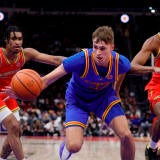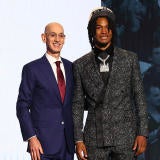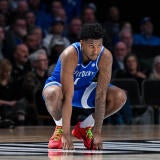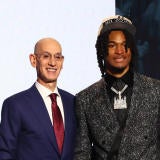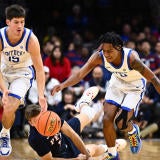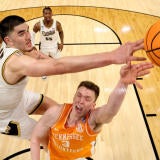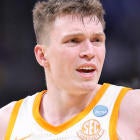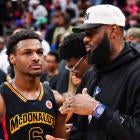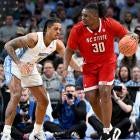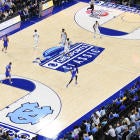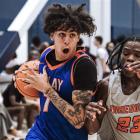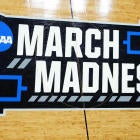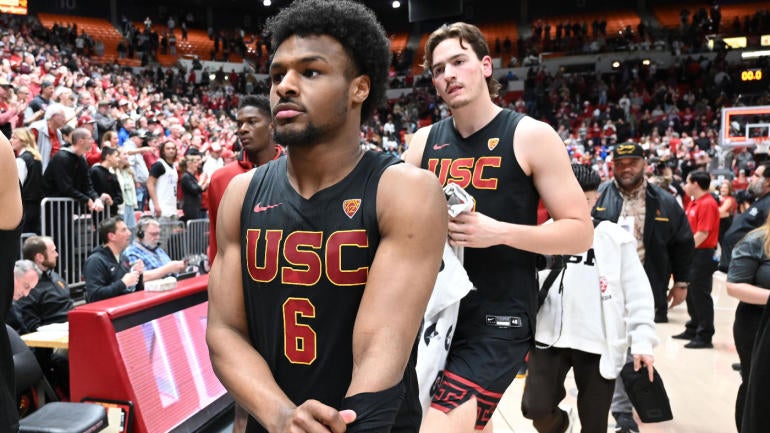
The 2024 NBA Draft withdrawal deadline passed last week, bringing college basketball programs one step closer to finalizing what their rosters will look like for the 2024-25 season. Not everyone got good news as a handful of programs that were holding out hope for the return of star players saw them depart for good.
For example: Dayton lost Atlantic 10 Player of the Year DaRon Holmes II, Memphis lost leading scorer David Jones and Kansas wing Johnny Furphy solidified his decision to turn pro. On the flip side, some big-time talents such as Alabama's Mark Sears, Arizona's Caleb Love and UConn's Alex Karaban chose to withdraw from the draft and return for another season of college basketball.
What goes into a stay-or-go decision differs for every player. All some need is the guarantee of a two-way contract at the next level in order to make the leap. Others want to be assured that they'll be selected in the first round and receive a guaranteed contract.
For last week's Dribble Handoff, we highlighted the players who made the best stay-or-go decisions at the deadline. This week, we'll take a look at the players who made the worst — or not even that: the most questionable, in some cases — decisions about where they're going to play next season.
Mark Armstrong, Villanova
As previously noted, I stopped getting worked-up about stay-or-go decisions from college athletes years ago. Everybody is running their own race. What matters to one person might not matter to the next. If I didn't properly understand that when I was younger, I do now. So I'm uninterested in judging anybody.
That said, I can be confused by some decisions.
Armstrong's decision confused me.
The Villanova guard actually announced last month, well in advance of the deadline to withdraw from the 2024 NBA Draft, that he would be remaining in the 2024 NBA Draft. Again, what do I care? But Armstrong is a 6-foot-2 guard who is unlikely to be selected later this month after merely being the fourth-leading scorer on a Villanova team that finished tied for sixth in the Big East and missed the NCAA Tournament. Why is somebody like that so eager to pursue not-so-great professional opportunities when an alternative plan could've been to simply enter the transfer portal and let the bidding start among coaches who work in college basketball, where a player like Armstrong should have much more value than he has outside of college basketball because of the money attached to NIL opportunities that are used as recruiting tools?
Does Armstrong just hate school?
If so, fine.
But the truth is that he could've spent next season playing on bigger stages and for more money than he will now that he's forgone his final two years of college eligibility. Hopefully, it works out for him. But it's always reasonable to wonder why somebody unlikely to get picked or even be given a notable contract after going unselected would walk away from a sport where lesser players are making lots. -- Gary Parrish
Cam Christie, Minnesota
Count me in the crowd that believes Christie would've gone 10-15 spots higher in 2025 than he'll go this year. In a weak draft, I understand why the one-and-doner out of Minnesota is looking to capitalize on his potential — with a guarantee he'll hear his name called between 20th and 40th.
Christie averaged 11.3 points on a 19-win Minnesota team that would've been boosted significantly if he opted to return. Had he portaled to a different destination, Christie would've probably commanded north of $750,000 in NIL earnings. And had he come back, there's a realistic scenario in which he could've popped as a top-40 player in college next season and catapulted that to top-20 stock in the 2025 Draft.
I don't think his decision is egregious — far from it — but I do think he's the increasingly rare case of a player opting in early who is leaving real earnings potential on the table by chasing the chance of being drafted in the first round. -- Matt Norlander
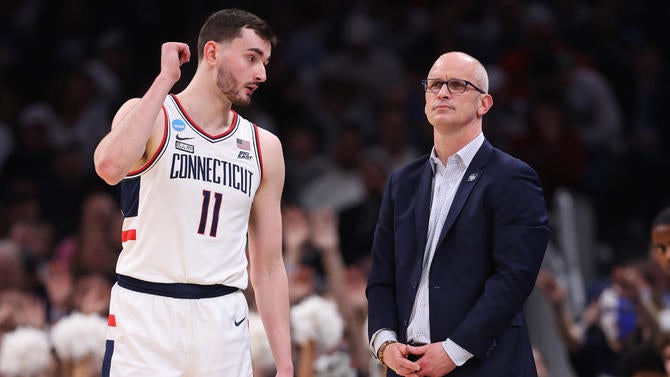
Alex Karaban, UConn
I'll swerve here on the topic and be the only of our bunch to take a player who actually returned to college instead of staying in the NBA Draft. In a soft 2024 draft class Karaban looked like a real first-round prospect and had a strong predraft process that included a solid showing at the combine. Coming off a second consecutive national championship, turning pro instead of staying in school seemed (from afar, to be clear) to be the better of the two options, just given where his stock is right now and the landscape of the current class.
It's obviously hard to fault a player for deciding to stay in school and continuing their education and impossible to criticize that decision with Karaban specifically -- he loves UConn, he's pursuing his education and his stock is likely to remain at or above the same level next cycle -- but, if placed in his shoes, I would've had a hard time passing up the prospect of being a potential first-rounder and kick-starting the pro career clock.
With Dan Hurley potentially considering a move to leave UConn to become the coach of the Lakers, it adds another wrinkle of uncertainty about next season that only further complicates what was already a tough stay-or-go decision. -- Kyle Boone
Bronny James, USC
You can't blame Bronny for capitalizing on the influence of his father, because that influence is likely going to get him drafted. While LeBron's power will be enough to get Bronny into the league, it likely won't be enough to keep him there. Bronny will be forced to develop from an average college guard to legitimate NBA player before LeBron, 39, retires.
Otherwise, once LeBron hangs it up, Bronny's charity spot on a roster will be gone, and Bronny's career prospects will look bleak. The alternative path would have been to stay in college for up to three more seasons and develop more organically, without all the criticism that is bound to come from his premature entry to the NBA.
It will be a special moment to see Bronny and LeBron take the court together. But the price for that memory is that Bronny will be deprived of the most logical developmental runway for a player of his caliber. In the long run, arguing that staying in the NBA Draft is truly what's best for Bronny's development is a tough sell. -- David Cobb
David Jones, Memphis
The reviews from the NBA Draft Combine about Jones' performance weren't great. On top of that, Jones projects as a UDFA or a very late second-round pick. Jones would've benefited more from coming back to school. It would've also benefited Penny Hardaway and Memphis tremendously if he decided to come back. After bouncing around at DePaul and St. John's, Jones had the best season with the Tigers, averaging 21.8 points, 7.6 rebounds and 1.8 assists.
If Jones decided to come back to school, he would've been an All-American candidate and Memphis would've been even more loaded. Jones will likely have to go the G League route in his first season as a pro, and the climb to get to the NBA will be steep. -- Cameron Salerno


